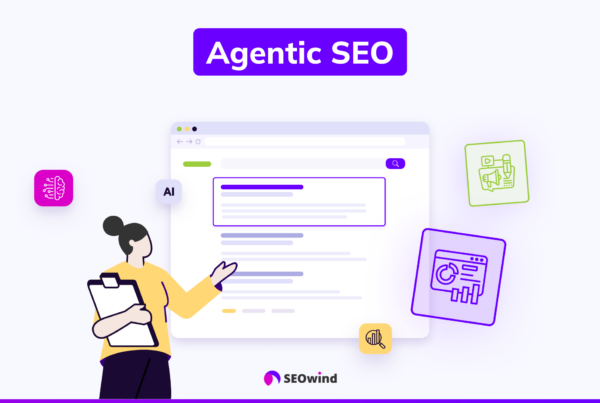Do you know that even the most exceptional writing might go unnoticed without proper search engine optimization (SEO)? That’s where SEO content analysis steps in – a powerful technique that can make your content stand out from the vast internet ocean. In this comprehensive guide, we’ll understand what it takes to analyze content and optimize your web presence. So, grab a warm cup of coffee, and let’s unravel the secrets behind skyrocketing your blog post and website rankings with the help of effective SEO content analysis.
What is SEO Content Analysis?

SEO Content Analysis is an essential process of evaluating and optimizing various components of your website’s content to improve its visibility on search engines like Google, Yahoo, or Bing. By doing so, businesses ensure their target audience finds them quickly when searching for information about their products or services. This not only improves organic traffic but also boosts the overall performance of websites.
In other words, it refers to fine-tuning your site’s content considering several optimization factors such as:
- Keyword Research & Targeting
- Search Intent & User Experience
- Content Performance & Readability
- Backlinks & Internal Links
When done correctly, SEO content analysis will aid in achieving higher search rankings by offering valuable insights into what works well for both users and search engines. Keep reading as we uncover the numerous benefits associated with this vital process and determine how you can maximize these advantages through strategic planning and implementation.
Benefits of Content Analysis SEO
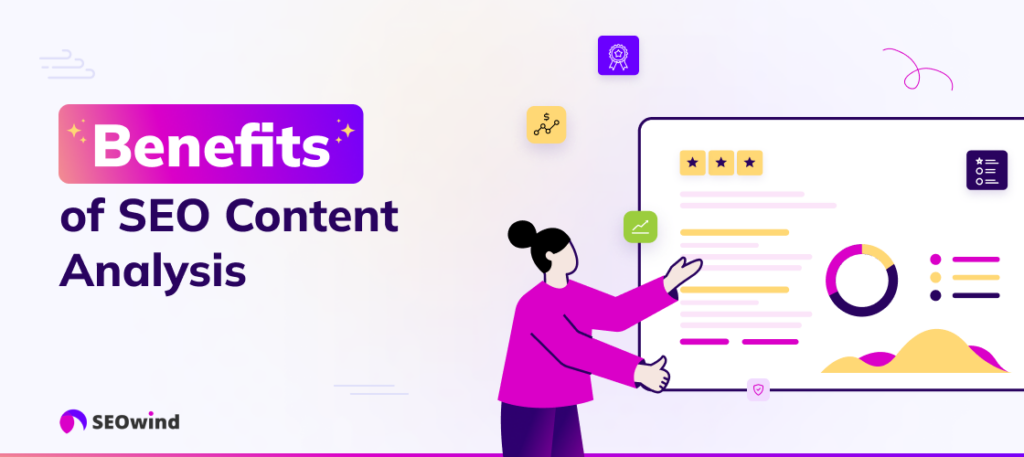
SEO content analysis offers many advantages to help businesses boost their online presence and achieve higher search rankings. Companies can enhance their content quality, increase organic traffic, and optimize search rankings for sustained competitive advantage by conducting regular content audits and utilizing the right tools.
Improving Content Quality
One of the primary benefits of SEO content analysis is enhancing the quality of your website’s content. This entails evaluating critical aspects like your target keyword, density and usage, search intent alignment, readability scores, user experience factors, and more. With this information, you can effectively improve your target audience’s needs.
Here are some ways in which SEO content analysis contributes to improved content quality:
- Identifying gaps in existing materials or subjects not adequately covered.
- Rectifying issues with spelling, grammar, sentence structure, and coherence to improve readability.
- Ensuring consistency in tone and style across all pieces of content on your site.
- Providing actionable insights for matching users’ search intent by offering richer context or examples.
By addressing these elements through strategic adjustments, you’ll deliver audience-centric value that ranks higher in search engines’ eyes.
Increasing Organic Traffic
Another significant benefit of conducting thorough SEO content analysis is the potential for increased organic traffic – visitors who reach your site through non-paid (organic) means. The more closely your overall web presence aligns with best practices tied to keywords research & targeting, optimal word counts, and backlinks profile optimization, ultimately leads to:
- Improved visibility on relevant SERPs (Search Engine Results Pages).
- Higher click-through rates due to enticing titles and meta descriptions
- Engagement level increases by enhanced user experience within pages
- Reduced bounce rates as visitors feel compelled towards deeper exploration instead of hastily moving off-page
Through targeted transformation efforts rooted in data-driven insights from SEO analysis, acquiring better-performing organic traffic becomes attainable across varied industry geographies.
Optimizing for Search Engines Rankings
A key outcome of expertly-executed SEO content analysis lies in the optimized search rankings that invariably follow. Implementing well-informed enhancements to your website’s textual offerings produces a two-pronged effect: strengthening current performance while future-proofing against potential algorithm changes and guidelines prescribed by search engine operators.
The meticulous content analysis leads to optimization strategies encompassing:
- Incorporating LSI (Latent Semantic Indexing) keywords for connected topical coverage.
- Enhancing site architecture with defined URL hierarchy and improved internal linking structures.
- Adapting content format variations such as text, graphics, infographics, or video forms for comprehensive options addressing diverse audience preferences.
- Monitoring competitors’ strategies and adapting your output accordingly.
Achieving superior search rankings thus involves an ongoing commitment towards regular SEO audits at all organizational levels – ensuring no aspect remains untouched in efforts to maintain leading positions within cutthroat digital arenas.
Key Elements of SEO Content Analysis
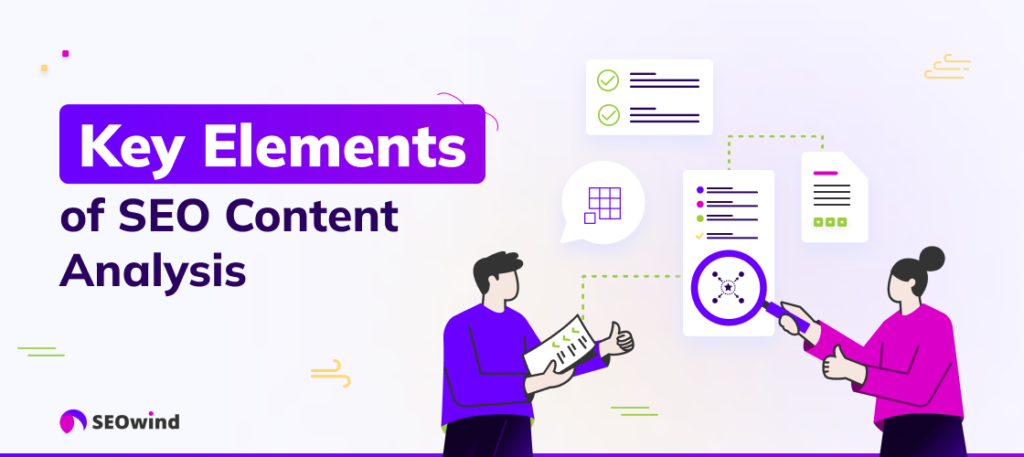
Effective content analysis for SEO purposes requires a comprehensive understanding of the essential elements that impact search rankings and user experience. Consider integrating these four critical components into your content strategy to optimize your website’s performance and boost visibility.
Keyword Research & Targeting
Proper keyword research is at the core of successful SEO content analysis. Using the right keywords allows search engines to understand your content better and display it to users searching for relevant topics. To effectively target keywords, follow these steps:
- Identify primary and secondary keyword phrases related to your topic.
- Use tools like Google Keyword Planner or Ahrefs to evaluate keyword competition, monthly search volume, and click-through rates (CTR).
- Conduct competitor analysis to explore other websites’ use of keywords and their ranking strategies.
- Distribute targeted keywords evenly throughout your content while maintaining readability.
Remember not to engage in keyword stuffing because this practice can lead to penalties from search engines.
Search Intent & User Experience
Understanding user intent goes hand-in-hand with solid keyword targeting. This involves determining what information users seek when engaging with your webpage or article. Specifically, you need to create content that fulfills their inquiries by respecting these three categories:
- Informational: Users seek educational or informational solutions
- Navigational: Users want assistance locating specific web pages or sites
- Transactional: Users aspire toward completing a transaction, e.g., making a purchase
Fulfilling user intent also means that created content has an excellent on-page user experience through proper formattings, such as headings, subheadings, bullet points, ordered lists, and engaging visual elements like images or videos where appropriate.
Content Performance & Readability
Another vital aspect of SEO content analysis involves evaluating the performance and readability of both new and existing content on your site. High-quality content should be accessible for users to consume while offering valuable insights capable of addressing concerns cited by your target audience. Specifically, focus on the following:
- Optimizing readability scores (aim for grade level 9 or below)
- Using short paragraphs and sentences
- Incorporating transitional phrases to enhance coherence
- Crafting relevant, engaging headings
Improving content performance also entails considering webpage structuring and optimally loading so users can easily find important information.
Backlinks & Internal Links
Lastly, focusing on backlinks and internal links can significantly boost your site’s authority among search engines through practical SEO content analysis. Compelling backlink profiles send positive signals to search engines by demonstrating that other websites consider the content valuable enough to link to it.
To improve your backlink portfolio, develop high-quality resources, utilize guest posting opportunities, and build relationships with reputable websites in similar industries. Additionally, prioritize innovative internal linking strategies by ensuring readers can navigate expertly around your website without confusion. Carefully interconnect related articles and direct additional traffic toward underperforming pages to ensure a balanced flow throughout the site.
Best Practices for SEO Content Analysis
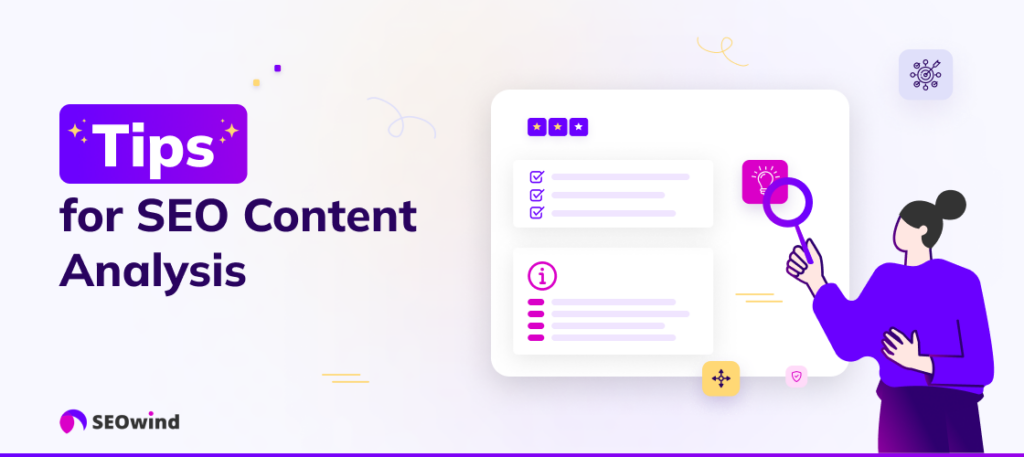
Following tried-and-tested best practices for SEO content analysis is essential to boost your website’s search rankings and performance. A systematic approach ensures thorough optimization and leaves no stone unturned in your content improvement journey.
The following three strategies are integral to successful content analysis:
Conduct a Comprehensive Audit
A comprehensive audit forms the backbone of any effective SEO content analysis strategy. It allows you to identify areas that require attention and optimization for better SERP performance. When performing an audit, make sure to focus on these critical aspects:
- On-page SEO: Review meta titles, descriptions, header tags (H1-H6), and image alt texts.
- Keyword usage: Assess proper use of primary and secondary keywords in titles, headers, meta descriptions, and throughout the content.
- Readability: Ensure your text follows good readability practices by examining sentence lengths, active voice usage, paragraph structure, vocabulary, and logical flow.
- Content quality Check your articles for plagiarism (duplicate content), relevancy, outdated information, factual accuracy,
- Backlink profile: Evaluate existing backlinks’ authority and relevance while identifying potential linking opportunities with quality web sources.
Working methodically through this list will highlight areas ripe for improvement within your website.
Analyze Competitors’ Content Strategies
Learning from competitors is a smart way to elevate your content strategy without reinventing the wheel entirely. By carefully dissecting their top-performing pages and understanding what works well among target audiences or search engines alike, you can apply these insights directly to your site’s output.
Here are a few ways to achieve this examination:
- Identify competitors who rank higher than you in search results for crucial target keywords. Identify content gaps.
- Examine aspects of those pages’ successes: superior keyword usage; rich multimedia elements; compelling headlines; strong backlink profiles.
- Observe how they address reader pain points, the overall structure of their content, and any recurring patterns among their top-ranking articles.
After understanding what sets your competition apart, incorporate these winning tactics into your unique approach for high search engine performance.
Optimize Title Tag & Meta Description
Two essentials attracting user clicks and, consequently, higher rankings are page titles (H1) and meta descriptions. Crafting compelling yet optimized text for both require careful consideration:
Page Titles:
- Use focus keywords early on for maximum impact
- Keep character count below 60 to avoid truncation in search results
- Appeal to users by addressing their needs or providing benefits
Meta Descriptions:
- Summarize the content while including target keywords conversationally
- Limit word count to 150 characters for the best visibility
- Inject curiosity or offer solutions readers desire
Implementing these SEO-focused best practices will elevate your site’s ability to engage users, ultimately improving click-through rates on SERPs and strengthening your position among competing web pages.
SEO Content Analysis Tools
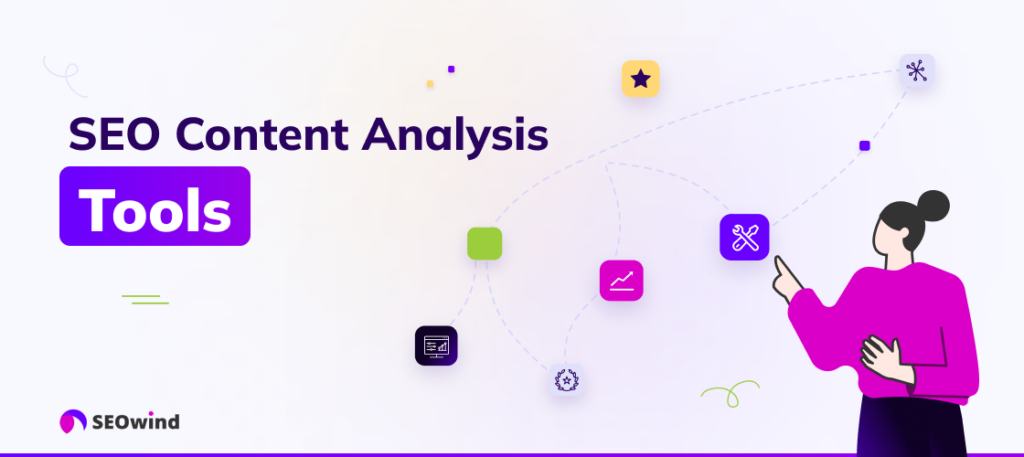
Having the right tools in your arsenal is essential for conducting practical content analysis and optimizing your website’s SEO. This section explores seven highly regarded tools to help you analyze content and improve content performance.
SEOwind

SEOwind is a comprehensive content analysis tool designed to help you create high-performing articles by offering keyword usage, word count, and more suggestions. It also gives you insights into top-ranking content on a focus keyword (title, description, keywords, outlines). What’s more, it provides you with questions your users have.
Google Search Console
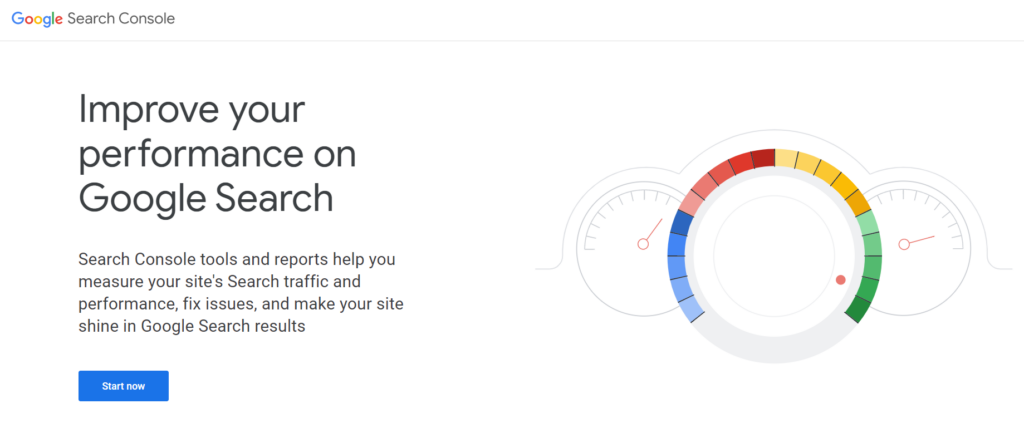
Google Search Console is an indispensable SEO content software, offering webmasters an in-depth look into a website’s search performance, indexability, and technical health.
By leveraging the data from this valuable platform, users can easily track keyword performance, discover potential issues with website crawling, and pinpoint any existing errors within a website’s schema markup.
Additionally, Google Search Console provides information on mobile usability and Core Web Vitals, which play crucial roles in enhancing the user experience and fulfilling Google’s algorithm requirements.
As a result, utilizing Google Search Console to its fullest potential serves as a stepping stone for online success, ensuring a website’s relevancy and visibility in the ever-competitive world of search engine optimization.
Clearscope
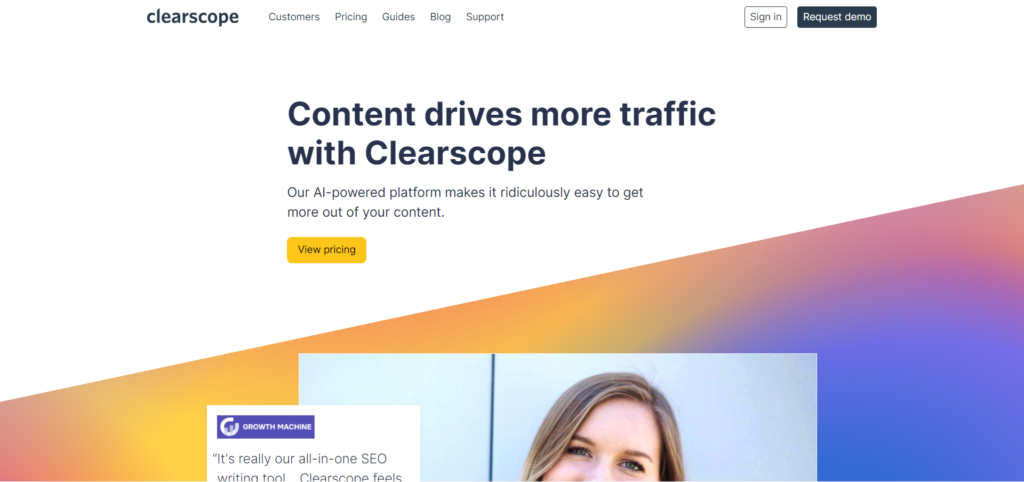
Clearscope has earned a reputation as an elite SEO content checker. Its primary focus is helping content marketers create relevant, optimized content aligned with search intent. Key features include:
- Competitor analysis.
- Real-time feedback on your writing quality.
- Keyword research data integration.
- Suggestions for enhancing overall relevance and performance.
With Clearscope’s actionable insights, you can be confident that your content stands above the competition.
Frase
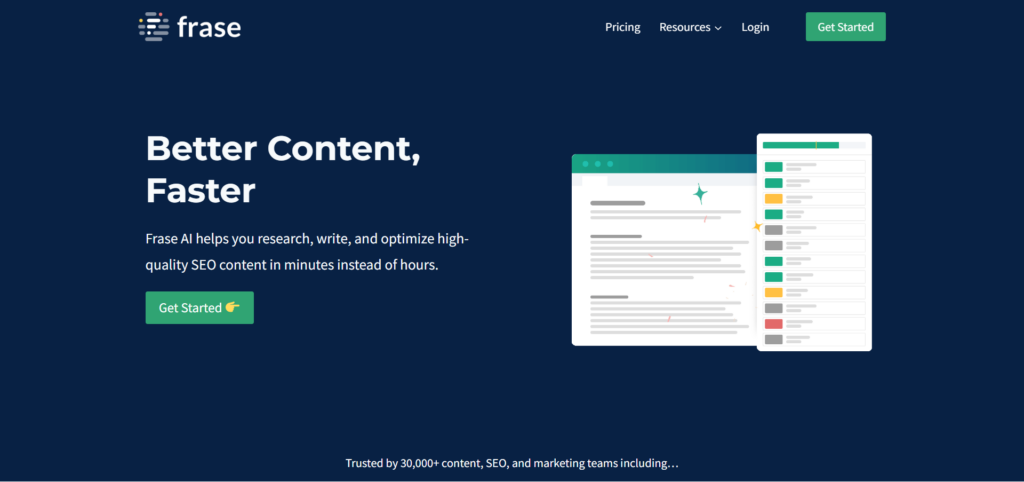
Frase is an AI-driven platform committed to improving user experience through understanding search intent. It offers a suite of tools catering to various stages of content creation – from automated research to topic cluster generation. Notable functionalities include:
- Question-based research automation (identifying popular questions related to your topic).
- Entity analysis for understanding topical niches better.
- AI-generated summaries of competing content.
GrowthBar
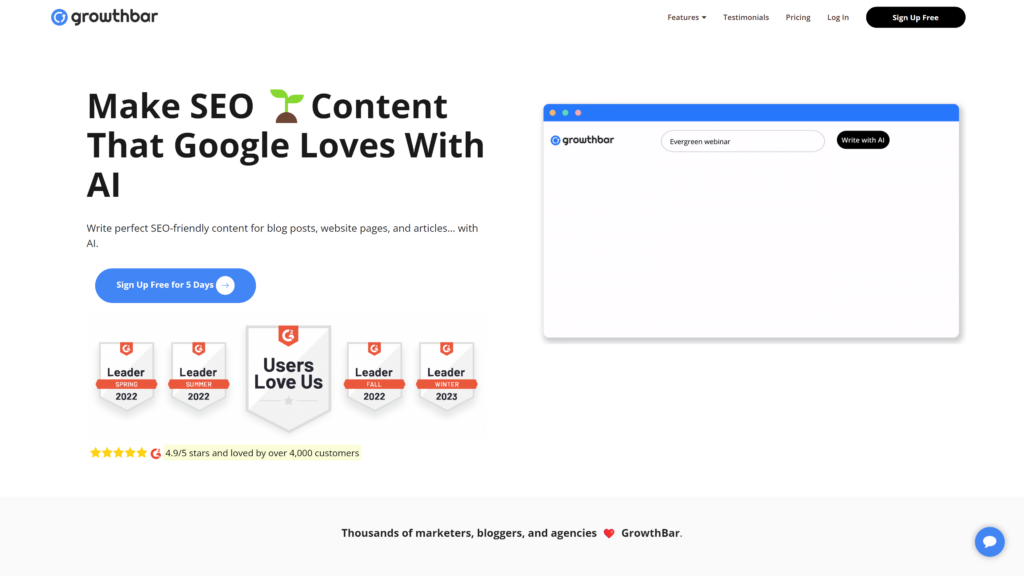
GrowthBar empowers users with powerful and easy-to-use solutions focused on enhancing SEO efforts. Some of its best features include:
- Keyword Research: Offers detailed data about ranking keywords and valuable stats like monthly search volume.
- Content Generation: Equipped with AI technology capable of creating reader-friendly blogs or article drafts.
- Organization: Users can track their most important metrics in one place.
- Backlink Explorer: Reveal your competitor’s backlink profiles.
Ahrefs
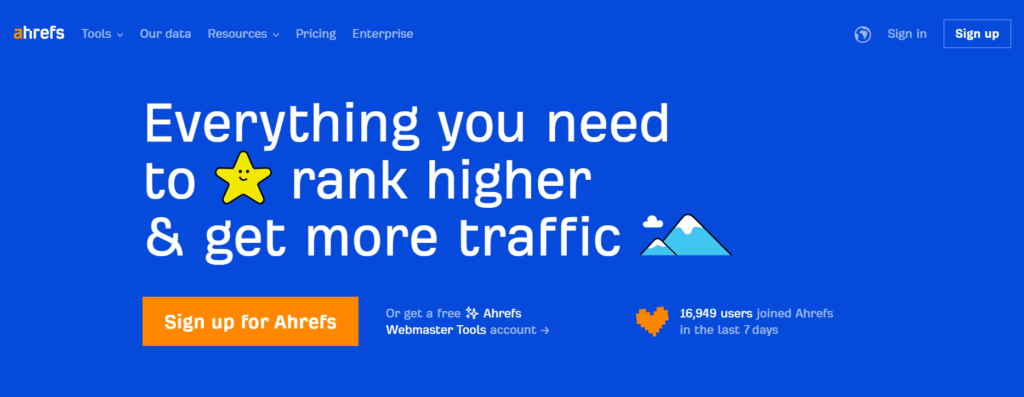
Ahrefs is a powerhouse in the SEO world, offering an extensive suite of tools for website optimization. Among its many capabilities, Ahrefs provides an in-depth analysis of essential aspects such as keyword research, backlinks, and content performance insights. You can use Ahrefs’ powerful Content Explorer tool to discover popular topics within your niche, analyze competitors’ strategies, and optimize your content accordingly.
MarketMuse
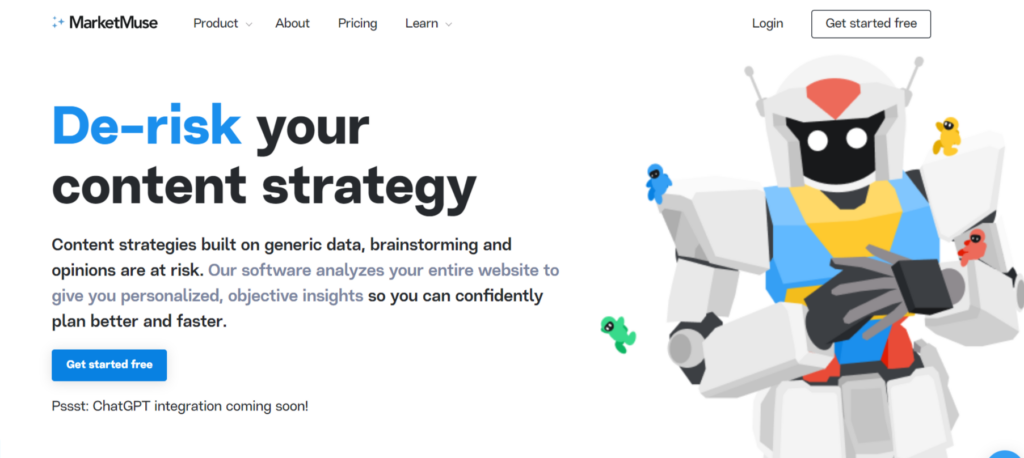
MarketMuse caters specifically to content creation professionals seeking data-driven insights that fuel higher-quality work. With AI at its core, this platform helps strategists plan topics more effectively and fine-tune written drafts to stand out. Major features include content planning assistance based on user needs and preferences (like audience or search intent), competitive analysis functions, and personalized suggestions for improving existing content and articles.
Keyword Insights
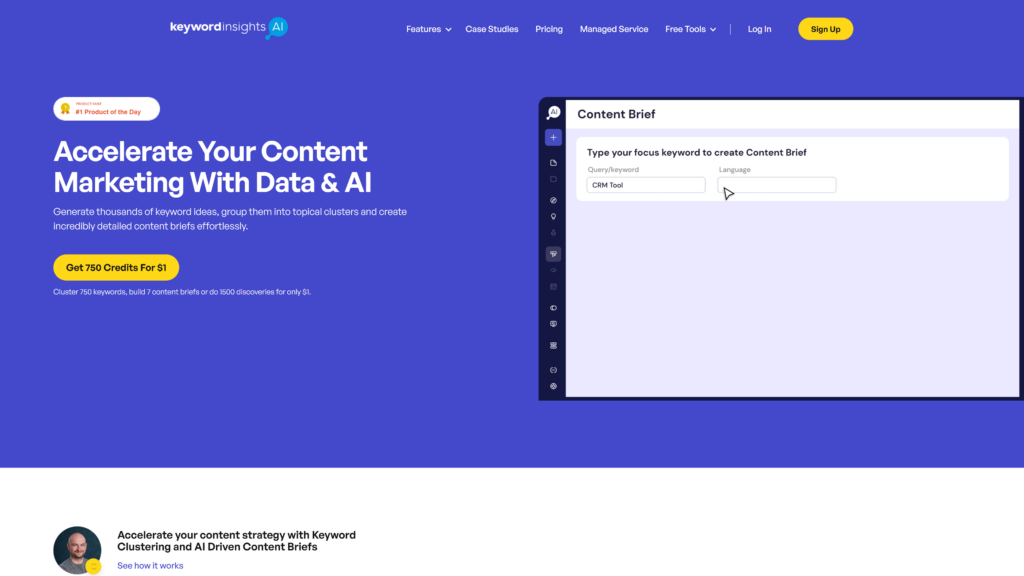
Lastly, KeywordInsights.AI is an emerging AI-based tool that simplifies various SEO tasks while delivering actionable improvement recommendations. This platform assists in identifying relevant keywords, analyzing competitor content strategies, optimizing headlines and meta descriptions to maximize click-through rates, and enhancing overall readability scores.
Investing time into selecting a suitable SEO content checker will reap significant benefits by ensuring higher-quality output resulting in improved rankings. Consider employing one or more of these tools when undertaking an effective strategy to boost
Analyzing Target Keyword & Search Intent
When it comes to SEO content analysis, one of the most crucial aspects is understanding and targeting keywords effectively. This involves identifying relevant keywords and interpreting the search intent behind them. This section will discuss conducting keyword research, determining search intent, and incorporating these insights into your content strategy for maximum impact.
Keyword Research
To begin with, keyword research is essential for discovering potential terms and phrases that users may use when searching for information related to your niche. There are various tools available for conducting keyword research; some popular options include the following:
- Google Keyword Planner
- Ahrefs
- SEMrush
- Moz Keyword Explorer
- Ubersuggest
While exploring potential keywords, consider short-tail (one to two words) and long-tail (three or more words), as they cater to different search queries. Furthermore, measuring monthly search volumes, competition levels, and cost-per-click data can help you prioritize the right keywords for your content strategy.
Determining Search Intent
Once you have compiled a list of important keywords, evaluating the search intent behind each term is essential – the purpose or goal driving a user’s query on a search engine. Understanding search intent allows you to create content tailored to your audience’s needs and expectations.
Search intent typically falls into four main categories:
- Informational: The user seeks knowledge or information about a specific topic or issue.
- Navigational: The user attempts to locate a particular website or online resource.
- Transactional: The user aims to complete an online transaction or take action on a website.
- Commercial investigation: The user compares different products or services before purchasing.
You can deduce search intent by observing organic search results on Google relating to your target keywords. Pay close attention to the types of content and websites that appear on the first page, including featured snippets, related questions, video carousels, and image results.
Incorporating Keywords & Search Intent Into Your Content Strategy
Armed with knowledge about relevant keywords and corresponding search intents, you can now optimize your content strategy for maximum impact:
- Map out target keywords to individual pages or pieces of content.
- Create high-quality, informative posts tailored to address each keyword’s search intent.
- Ensure your content remains conversational and engaging while incorporating target keywords naturally.
- Optimize meta titles and descriptions to include these targeted keywords effectively.
In conclusion, analyzing keywords and their respective search intentions is a critical component of SEO content analysis. By adapting your content strategy accordingly, you can improve overall website performance and boost your rankings in search engine results.
Improve Readability Score
The readability of your content plays a crucial role in attracting and retaining website visitors. A high readability score means your content is easy to understand and grasp, even for readers with a lower education level. In this section, let’s discuss the importance of improving your content’s readability score, the various factors affecting it, and some practical strategies you can implement.
Why Focus on Readability?
Studies show online users have limited attention spans and prefer reading straightforward, easy-to-digest content. Focusing on readability allows you to communicate complex ideas effectively, catering to a broader audience. Moreover, search engines like Google prioritize websites with explicit, well-structured content, contributing to higher rankings.
Here are some benefits of having a high readability score:
- Enhanced comprehension: Clear and concise text promotes better understanding among your target audience.
- Better retention: An improved readability score lets users recall essential information quickly.
- Increased engagement: Easy-to-read articles result in longer dwell times on your page.
- Improved SEO ranking: A higher readability score contributes to overall user experience (UX), directly influencing search engine rankings.
Factors Affecting Readability Score
Various elements contribute to a piece of content’s readability score:
- Sentence length: Shorter sentences are more straightforward for readers.
- Vocabulary choice: Using simpler language appeals to a broader range of audiences.
- Structure: Organized headings, subheadings, bullet points, and numbered lists make the text easier to navigate.
- Tone: Adopting an active voice creates engaging writing that resonates better with readers.
Strategies for Boosting Your Readability Score
By employing these practices centered around the previously mentioned factors, you can effectively improve your website’s readability:
- Limit sentence length: Aim for an average sentence length between 10-15 words while ensuring contextual clarity.
- Simplify vocabulary: Avoid technical jargon and complex terms that cater only to experts. Optimize your content for the average reader.
- Utilize proper formatting: Break up large blocks of text with appropriate headings, subheadings, bullet points, and numbered lists. This enhances readability by facilitating easy scanning for readers seeking specific information.
- Maintain an active voice: Writing in an active voice maintains a conversational tone while keeping the content authoritative.
By improving your site’s readability score through content analysis SEO strategies—such as simplifying vocabulary and maintaining a conversational tone—you enhance user experience and pave the way for better search rankings. Remember that readability is an essential factor affecting organic traffic; investing time into refining your content can significantly improve your website’s overall performance.
Optimize Click Through Rates
Optimizing Click Through Rates (CTR) is essential to a successful content analysis SEO strategy. A higher CTR indicates that your content appeals to users, which can positively impact your site’s rankings and improve organic traffic. In this section, we will explore various strategies for enhancing the CTR of your content.
Crafting Engaging Meta Titles & Descriptions
Designing a captivating meta title and meta description is one of the most effective techniques to increase your CTR. These elements are essential in attracting users’ attention when they see your website listed in the SERPs (Search Engine Results Pages). Consider using action-oriented language, clear value propositions, and relevant keywords from the clustered list like “content seo tool” or “SEO article checker” within these vital areas to help improve click-through rates.
Leveraging Schema Markup
Schema markup is another powerful method for optimizing CTR. By utilizing structured data on your page, you provide search engines with additional details about the information available on your site. This enhanced information allows more dynamic snippets called rich results to appear in search listings; adding visual appeal and offering valuable context can lead to increased user engagement.
Examples of schema markup include:
- Reviews and ratings
- Event dates
- Product prices
- Breadcrumb navigation
Including such structured data gives users a better understanding of what they’ll find on each web page before clicking through, increasing the likelihood of clicking on links that interest them.
Focusing on Readable URLs
Readable and descriptive URLs also have their part in boosting CTRs. Ensure your URL structure closely aligns with search intent and relevancy regarding target keywords. Implementing hyphen-separated words within URLs ensures readability for users struggling to identify pertinent information rapidly. Incorporating relevant keywords from clusters like “seo text analysis” can assist in reinforcing topical relevance and conveying commercial benefits provided by accessing specific landing pages.
Optimizing for Featured Snippets
Featured snippets offer a prime opportunity to capture additional organic traffic. To increase your chances of appearing in featured snippets, structure content with well-organized headers and bullet points that concisely answer critical user queries. Targeting question-based search terms and utilizing long-tail keywords can also improve the likelihood of earning these valuable SERP placements.
In conclusion, optimizing click-through rates is a crucial aspect of SEO content analysis, bringing meaningful results through higher rankings and broader visibility. By crafting engaging meta titles and descriptions, leveraging schema markup, emphasizing readable URLs, and focusing on featured snippets, you are more likely to see increased user engagement – rewarding benefits for your site’s overall success.
Improve Backlink & Internal Link Profiles
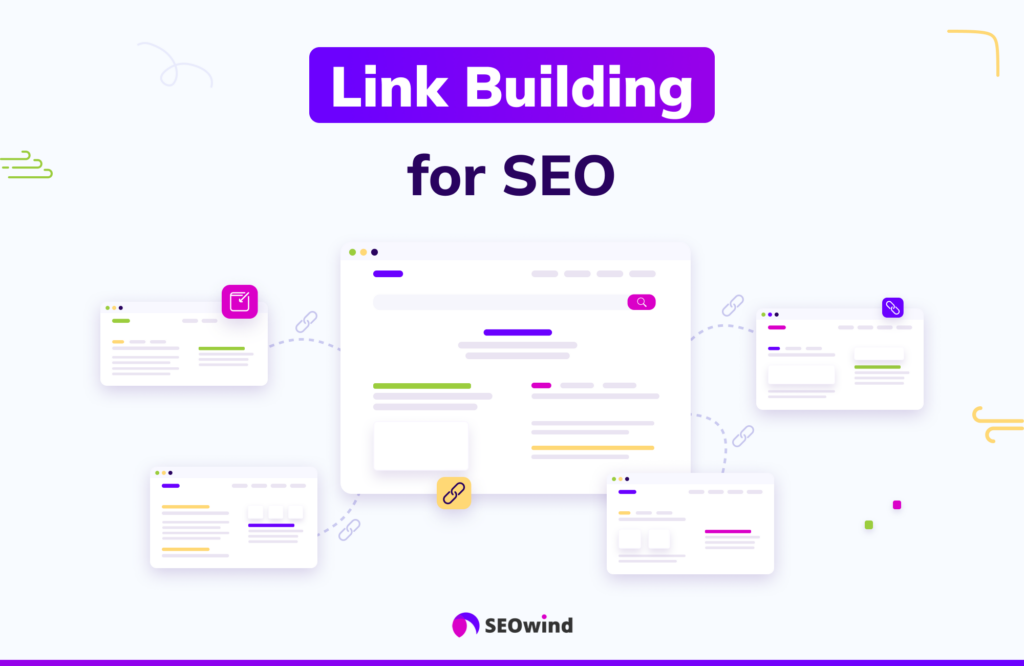
A crucial aspect of SEO content analysis is evaluating and enhancing your website’s backlink and internal link profiles. Strong link profiles create a robust network that can build up your site’s authority, visibility, and credibility in search engine rankings. Let’s delve deeper into the importance of both types of links and how to optimize them.
Significance of Backlinks
Backlinks, or inbound or external links, are connections from other websites pointing to your pages. These play a pivotal role in assuring search engines about the relevance and credibility of your content. Quality backlinks from authoritative sites can significantly boost your domain’s authority while improving search engine rankings. Some key factors to consider when analyzing backlinks include the following:
- Link quality: Acquiring links from high-authority domains is essential for better SEO results.
- Diversity: An optimal mix of anchor texts can improve user experience and signal relevancy to search engines.
- Relevance: Ensure that the linking websites align with your niche; this enhances overall domain value.
Enhancing Your Backlink Profile
To enhance your backlink profile, consider implementing these strategic tactics:
- Create valuable, shareable content that attracts organic backlinks
- Engage in genuine networking with blog owners within your niche
- Use social media platforms to promote compelling articles
- Reach out to influencers for increased visibility
- Participate actively in industry forums and community discussions by providing helpful insights
- Analyze competitor backlinks as potential opportunities
Remember that acquiring numerous low-quality links may harm your website’s ranking, so always prioritize quality over quantity.
The Role of Internal Links
Internal links refer to connections between different pages on your website, guiding users through relevant content while establishing site structure for search engines. A well-designed internal link structure allows search crawlers easier access and navigation across pages which, in turn, results in better indexing and visibility.
Strengthening Your Internal Link Profile
Optimizing your internal link profile can be accomplished by:
- Incorporating keyword-rich anchor text that accurately depicts linked content
- Linking to essential pages with higher priority from multiple locations within the site
- Balancing link distribution across all pages to boost overall crawlability and user experience
- Regularly updating older posts with fresh links directed toward new content
Focusing on backlinks and internal link profiles will help your website rank higher in search engines. Utilize SEO content analysis tools and techniques mentioned earlier for the best optimization practices to stay ahead of the competition while delivering an unparalleled experience for your audience.
Resources
Staying up-to-date and improving your SEO content analysis skills is essential in today’s digital landscape. This section highlights valuable resources that can help you enhance your understanding of the best practices for content analysis, explore new strategies, and stay informed about industry changes.
- SEO Blogs & Newsletters: Following authoritative blogs in the SEO field helps you stay updated on the latest trends, algorithm updates, and proven tactics. Some reputable publications include Moz Blog, Search Engine Journal, Backlinko, SEMrush Blog, Ahrefs blog, and Neil Patel’s website. Subscribing to their newsletters makes it easier to follow new releases while keeping all the valuable information at your fingertips.
- Online Courses & Workshops: Enhancing your knowledge with structured online courses gives you a stronger foundation in SEO content analysis. Industry leaders such as Yoast Academy and Coursera offer comprehensive lessons that cover various aspects like keyword research, search intent understanding, and site auditing, among others. Additionally, attending workshops or webinars provides a platform for direct interaction with experts who can answer your questions or guide you through any challenges you might be facing.
- Industry Podcasts: Listening to podcasts from respected names in SEO offers insights into analyzing your content successfully and navigating ongoing industry shifts more efficiently. Episodes featuring interviews with top practitioners share real-life experiences and case studies providing invaluable inspiration when refining your approach toward SEO content analysis tools. Examples include The Authority Hacker Podcast by Gael Breton & Mark Webster and Experts on The Wire by Dan Shure.
- Forums & Communities: Participating in online forums or joining professional networks dedicated to SEO connects you with peers who share similar interests — thus creating an opportunity for learning by sharing ideas and discussing techniques. Platforms like Reddit’s r/SEO community or Facebook groups enable productive conversations around strategies for optimizing websites better using innovative content analysis methods.
- SEO Conferences: Attending SEO conferences allows you to engage with industry thought leaders and expand your horizons through keynote presentations, panel discussions, workshops, or Q&A sessions. Notable events include Content Marketing World, BrightonSEO, Pubcon, SMX Advanced, MozCon, and INBOUND.
In conclusion, staying informed about the fundamental skills essential in the area of content analysis for SEO will ensure increased optimization levels. By continuously seeking new techniques and looking for updates from these resources, you should find it easier to maintain a competitive edge that lets you and your site thrive.


